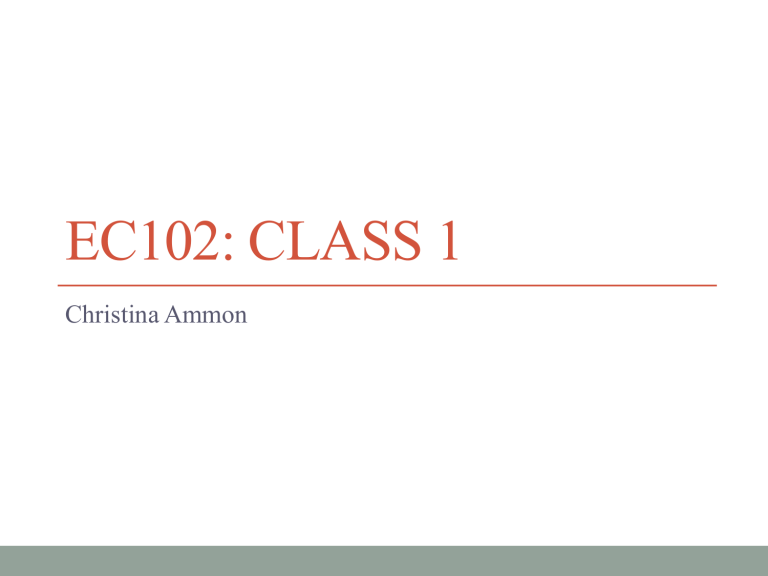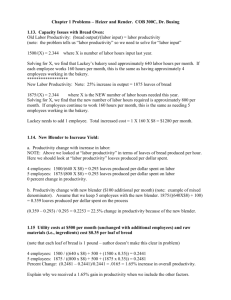EC102: Class 1 - University of Warwick

EC102: CLASS 1
Christina Ammon
Basic information
(Kerstin) Christina Ammon
K.c.ammon@lse.ac.uk
Office hour:
•
• Monday 13:30-14:30
LG32 1.30
Pigeon Hole in LG32 1.01
Administration
Complete Moodle Quizzes – it can only help you
Problem Sets – hand in in class or send by mail
No extensions!
Especially for Micro: pay attention to the book + source of additional excercises
If you have done Economics at school…
Economics is made up of different models people have thought of to explain reality
Models/Theories are not the truth
•
Will encounter a few models that contradict each other some models are able to explain some facts well, some can explain others
For the exam in this course you are expected to know the models taught in this course
If you learned different models at school: you can add them (if it adds value), but don’t use them instead
!
Question 1
“Saudi Arabia can pump all the oil it needs. Therefore, consumption of oil is free in Saudi Arabia”. This statement is:
• True
• False
Question 2
•
•
•
Suppose the crisis has reduced the extra money high-skill jobs pay relative to low-skill ones. Accordingly:
More people attend school
People quit education earlier
People quit education later
Question 2
•
•
•
What is the marginal cost of education
Fees
Effort
Forgone Wages
•
•
•
What are the benefits of education
Higher wages
Enjoyment
Alternative Advantages
Question 2
Question 2
•
•
•
Suppose the crisis has reduced the extra money high-skill jobs pay relative to low-skill ones. Accordingly:
More people attend school
People quit education earlier
People quit education later
Question 3
•
•
•
•
If bread and butter must be consumed together, an increase in the price of butter:
Increases the price of bread
Increases the number of loaves consumed
Has no impact on the price of bread and the number of loaves consumed
Decreases the price of bread and the number of loaves consumed
Question 3
What are complements?
What are perfect complements?
What is the shape of the demand curve?
What is the shape of the supply curve?
Question 3
•
•
•
•
If bread and butter must be consumed together, an increase in the price of butter:
Increases the price of bread
Increases the number of loaves consumed
Has no impact on the price of bread and the number of loaves consumed
Decreases the price of bread and the number of loaves consumed
Rationality Assumptions
Completeness
Transitivity
Non-satiation
Diminishing Marginal Rate of Substitution
Question 4
•
•
•
•
Sue can choose between 10 memory sticks and 5 software manuals, or 9 memory sticks and 20 software manuals. If her tastes are complete, transitive and non-satiated:
We can predict she will choose the first option
We can predict she will choose the second option
We can predict she will be indifferent between the two options
We cannot predict her choice
Question 5
•
•
•
•
Louise is purchasing 150 Russian novels and 30 comic books.
She would be willing to give up 3 Russian novels for 2 more comic books. Her marginal rate of substitution of Russian novels for comic books is:
1
0.5
1.5
5
Marginal Rate of substitution
How much of good x are you willing to give up in order to gain one unit of good y
Marginal utility = the utility you gain from consuming one more unit of good 1
MRS x,y
=MU y
/MU x
Question 5
•
•
•
•
Louise is purchasing 150 Russian novels and 30 comic books.
She would be willing to give up 3 Russian novels for 2 more comic books. Her marginal rate of substitution of Russian novels for comic books is:
1
0.5
1.5
5
Question 6
•
•
•
•
The marginal rate of substitution of 20-cent coins for 50-cent coins is:
1
0.4
2.5
5
Question 7
•
•
•
A university had initially allocated £500k to lectureships and scholarships, each of which costs £50k and £10k respectively.
Its trustees have later reduced the overall budget to £300k.
Hence, the opportunity cost of a scholarship has:
Fallen
Increased
Remained unchanged
Budget Constraints
What is a budget constraint?
All the the combination of (two) goods the agent can afford at most
The university’s budget constraint is 500,000 = 50,000 × f +
10,000
× s
What happens if Income is reduced?
What would change the optimal allocation?
Question 7
•
•
•
A university had initially allocated £500k to lectureships and scholarships, each of which costs £50k and £10k respectively.
Its trustees have later reduced the overall budget to £300k.
Hence, the opportunity cost of a scholarship has:
Fallen
Increased
Remained unchanged
Question 8
“There are some things money can’t buy, but these days, not many. Today, almost everything is up for sale … we drifted from having a market economy to being a market society. The difference is this: A market economy is a tool – a valuable and effective tool – for organizing productive activity. A market society is a way of life in which market values seep into every aspect of human endeavour. It’s a place where social relations are made over the image of the market.” (Michael J. Sandel)




